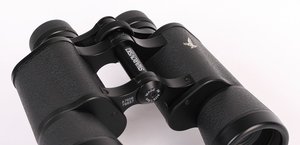| Real front lens diameter |
Left: 49.32+/-
0.05 mm
Right: 49.33+/-
0.05 mm
|
5 / 8.0 pkt |
| Real magnification |
12.19+/-
0.05x
|
3/3.0 |
| Transmission |
78.3+/-
1%
|
9/25.0 |
| Chromatic aberration |
ED glass effect visible at once – in the field centre chromatic aberration is very low, medium at most on the edge. |
7.5/10.0 |
| Astigmatism |
Average level. Stars spark a bit. |
5.8/10.0 |
| Distortion |
Distance between the first curved line from the field centre compared to the field of view radius: 44% ±2% |
4.5/10.0 |
| Coma |
Appears in a distance of 70% of the field of view radius and is medium on the very edge. |
7.3/10.0 |
| Blurring at the edge of the FOV |
Blur occurs in a distance of 77% ± 3% from the field of view centre. |
5/10.0 |
| Darkening at the edge the FOV |
Moderate. |
3.2/5.0 |
| Whiteness of the image |
Heavily slanted transmission graph with a huge loss when it comes to purple-blue light; the highest results for orange-red part of the spectrum. Respectively, such is also dominating colouring of images. |
2.8/5.0 |
| Collimation |
Perfect. |
5/5.0 |
| Internal reflections |
| Left: |
Right:
|
 |
 |
A weak arc visible not far away from the exit pupil. |
3.9/5.0 |
| Housing |
Very shapely and stylish – rather small and lightweight for the 12x50 class. Padded with good quality rubber armour that sticks to the casing of the binoculars quite well, being a bit too loose only near the objective lenses. Slight, rubberized eyecups with four detention stops. Produced in China. |
7.5/8.0 |
| Focusing |
Huge, ribbed central wheel that works properly well with a full range of as much as 900 degrees – there is sometimes a lot of turning. Joystick next to tthe central wheel for dioptre correction. Nothing moves outside – a rarity at this price point. |
5/5.0 |
| Tripod |
A comfortable access for a tripod socket. |
3/3.0 |
| Interpupilary distance |
from 58.3 to 75.1mm
|
5/6.0 |
| Closest focusing distance |
2.45 meters. |
2/2.0 |
| Eyepieces FOV |
Apparent field of view of 64.9 degrees (simplified formula) and 59.0 degrees (tangent formula). |
14/20.0 |
| Field of view |
Measured by us amounted to 5.32 +/- 0.04 degrees and was in perfect accordance with specifications. A wide field for this class of equipment. |
6.5/8.0 |
| Quality of the interior of the barrels |
Nicely blackened, matted, and ribbed tubes. A wide bottom near prisms is black, a smaller bushing is dark, everything as blackened as it should. Very few specks of dust on prisms. |
4.8/5.0 |
| Vignetting |
| Left: |
Right:
|
 |
 |
OL: 0.42%, OR: 0.67% |
7/8.0 |
| Prisms quality |
High quality BaK-4 glass. |
8/8.0 |
| Antireflection coatings |
Green-orange on objectives, green-blue on the prisms, green-yellow on eyepieces. Medium intensity. |
4.5/5.0 |
| Warranty [years] |
10 |
4.5/6.0 |
| Final result |
70.4%
|
133.8 / 190 pkt
|
| Econo result |
|
0pkt. |
Summary
Pros
- shapely and very stylish casing,
- lack of any serious problems with chromatic aberration,
- moderate coma,
- nicely blackened area near exit pupils,
- proper blackening and cleanliness inside the tubes,
- prisms made of BaK-4 glass,
- internal focusing and dioptre correction.
Cons:
- too weak transmission,
- just average colour rendering.
The Delta Optical Chase ED series is very even – all its models managed to exceed a very good level of 130 points in our tests. Taking into account the prices of these binoculars, which amount to just a bit more than 200 Euro, you have to admit the products are really worth your attention.

Delta Optical Chase ED 12x50 and Vortex Crossfire HD 12x50. |
If you add to that a very stylish, shapely casing of very good quality it would be difficult to find any serious fault with these instruments.
Of course you can always pick holes in the performance and here we have to admit the antireflection coatings are certainly a weak spot. It seems they can differ not only from model to model, but also from one batch to another, from one delivery to the next. Mind you the evolution is not always going in the right direction...
If you compare transmission graphs of particular models you find huge differences even though you deal here with one series of binoculars. As it happens, the 12x50 model has the most of issues in this area. Perhaps it stemms from the fact that its eyepiece is optically the most complex of all, perhaps there are other reasons; still, the result is such that the transmission curve of this model is very slanted, with a huge loss of purple and blue light. The effect? Colour rendering, offered by the 12x50 model, we found rather poor for contemporary standards.
As you see there are no miracles but, with such a low price tag, you would be foolish to expect a perfect pair of binoculars, without any compromises. Of course all these slip-ups aren't able to change our good opinion of the Delta Optical Chase ED series as a whole, and never forget about its great value for money/price-performance ratio.





















